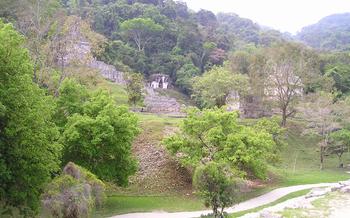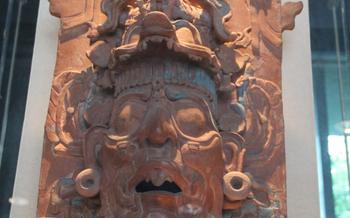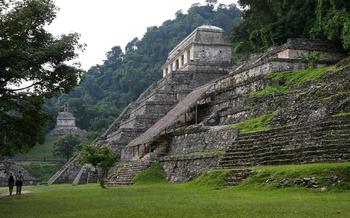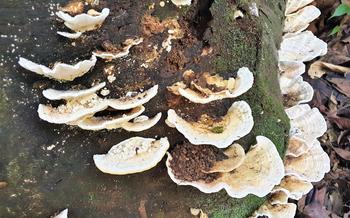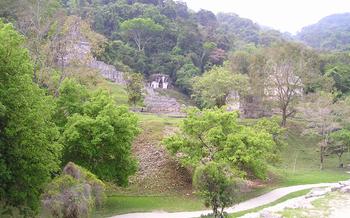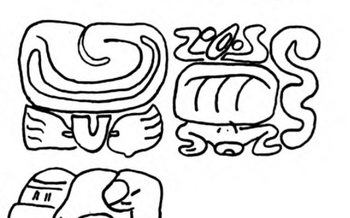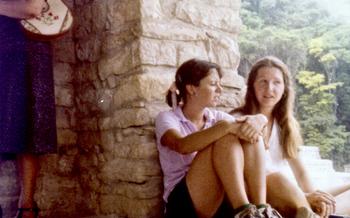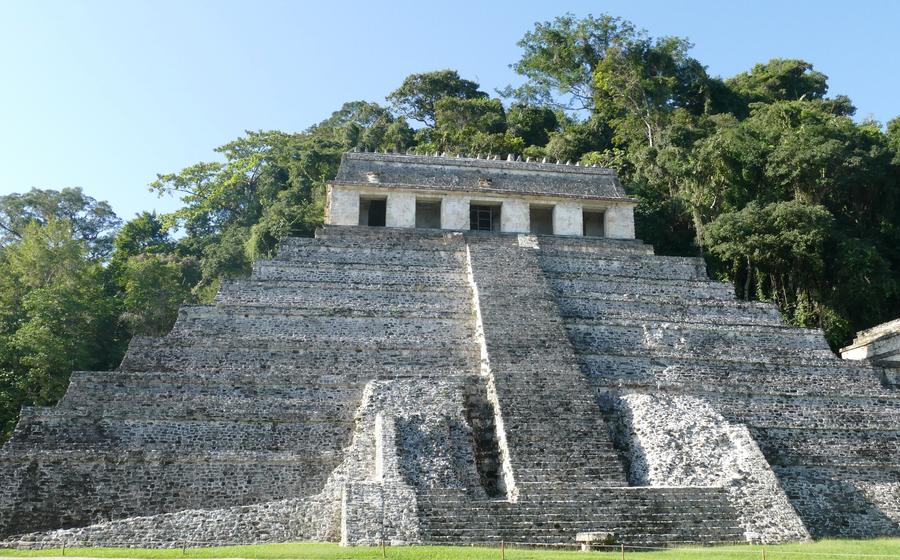
Temple of the Inscriptions
- The Temple of the Inscriptions: A Timeless Wonder
- Unveiling the History: Back in Time
- A Journey to the Temple: Through Lush Landscapes
- Entering the Sacred Space: Unveiling the Temple's Secrets
- Exploring the Temple's Exterior: A Tapestry of Art
- Inside the Temple: A Glimpse into the Afterlife
- Unearthing the Secrets: The Discovery of King Pakal's Tomb
- In the Footsteps of Ancient Rulers: A Guided Tour
- A Walk Through History: Exploring Palenque's Archaeological Site
- Notable Structures Within the Site
- Urban Layout and Significance
- Importance in Maya Civilization
- Palenque's Enchanting Surroundings: A Natural Paradise
- Unveiling the Mysteries: The Hieroglyphic Stairway
- Cultural Immersion: Experiencing Maya Traditions
- Convenient Accommodations: A Pleasant Stay
- Practical Information: Planning Your Visit
- Insider Tip: Unveiling the Hidden Gem
The Temple of the Inscriptions: A Timeless Wonder
A Journey Through Time and Majesty
In the heart of the ancient Maya city of Palenque, Mexico, stands the Temple of the Inscriptions, a testament to the ingenuity, artistry, and spiritual beliefs of this enigmatic civilization. This awe-inspiring structure, built during the reign of King Pakal the Great in the 7th century, has captivated the world with its architectural grandeur, intricate carvings, and historical significance.
The temple's name derives from the discovery of over 600 hieroglyphic inscriptions adorning its walls, providing invaluable insights into Maya history, culture, and mythology. These inscriptions tell the tale of King Pakal's life, his reign, and his journey to the afterlife, offering a glimpse into the Maya worldview and their profound belief in the interconnectedness of life, death, and rebirth.
The temple's imposing facade, adorned with intricate carvings and a towering roof comb, hints at the wonders that lie within. Its nine levels, representing the Maya underworld, invite visitors to embark on a journey through time and space, descending into the depths of the earth to uncover the secrets of the Maya cosmos.
Unveiling the History: Back in Time
The Temple of the Inscriptions was built during the reign of King Pakal the Great, who ruled Palenque from 615 to 683 AD. Pakal was one of the most powerful and influential Maya rulers, and his reign marked a period of great prosperity and expansion for the city. The temple was constructed as a burial chamber for Pakal, and its elaborate design and decoration reflect the importance of his legacy.
The temple's location within the archaeological site of Palenque is significant, as it is situated on a natural hill that overlooks the city. This elevated position symbolizes Pakal's status as a divine ruler and his connection to the gods. The temple's construction also showcases the Mayan architectural prowess and their ability to create structures that are both functional and aesthetically pleasing. The use of intricate carvings, vibrant colors, and symbolic motifs adds to the temple's grandeur and reflects the Maya's deep connection to their cultural and religious traditions.
The discovery of the temple in the 20th century shed new light on the history and culture of the Maya civilization. The unveiling of Pakal's tomb and the discovery of his intricately carved sarcophagus provided valuable insights into Maya burial practices and beliefs about the afterlife. The hieroglyphic inscriptions on the temple walls have also provided historians and archaeologists with important information about the Maya's political and religious systems, as well as their understanding of astronomy and mathematics.
A Journey to the Temple: Through Lush Landscapes
The Temple of the Inscriptions is nestled within the heart of Palenque's archaeological site, surrounded by a verdant rainforest that paints a mesmerizing backdrop. To reach this enigmatic structure, visitors can embark on a captivating walk through the lush vegetation, immersing themselves in the beauty of nature. The journey on foot offers a unique opportunity to appreciate the rich biodiversity of the region, as colorful birds flutter among the trees and exotic flowers bloom along the path. Alternatively, guided tours are available for those who prefer a more in-depth exploration, with knowledgeable guides providing insights into the history, culture, and significance of the site. The walk to the temple takes approximately 30 minutes, allowing ample time to soak in the tranquility of the surroundings and build anticipation for the wonders that lie ahead.
Entering the Sacred Space: Unveiling the Temple's Secrets
A majestic entrance, framed by intricate carvings and towering pillars, grants access to the Temple of the Inscriptions. As you step inside, you embark on a journey through time, descending nine levels, each representing a layer of the Mayan underworld. Narrow passageways and steep steps lead you deeper into the temple, creating a sense of awe and anticipation.
In the heart of the temple, the inner sanctum awaits, where King Pakal's sarcophagus lies, shrouded in mystery and grandeur. Its intricate carvings narrate tales of his life, death, and rebirth, offering a glimpse into the ancient Maya's beliefs and rituals. The air is thick with history, and the silence is palpable, broken only by the echo of your footsteps.
The temple's interior is an artistic masterpiece, adorned with stunning paintings and bas-reliefs that depict scenes from Maya mythology and daily life. Every corner reveals a new wonder, a testament to the skill and artistry of the ancient Maya.
Emerging from the temple, you carry with you a sense of awe and a deeper understanding of the Maya civilization. The Temple of the Inscriptions has unveiled its secrets, leaving you with a lasting impression of its architectural marvels and the enduring legacy of King Pakal the Great.
Exploring the Temple's Exterior: A Tapestry of Art
The exterior of the Temple of the Inscriptions is adorned with an array of intricate carvings and sculptures that offer a glimpse into the artistic prowess of the ancient Maya. The elaborate roof comb that crowns the temple is a testament to their architectural ingenuity. It features intricate carvings depicting mythological scenes, deities, and rulers, forming a mesmerizing tableau of Maya mythology.
Exquisite sculptures adorn the temple's facade, portraying Maya rulers and deities with remarkable detail. These sculptures provide a vivid representation of the Maya people, their beliefs, and their reverence for their leaders and gods. The figures are depicted with intricate headdresses, elaborate garments, and ceremonial adornments, showcasing the Maya's mastery of stone carving.
Symbolic motifs and intricate glyphs are interwoven throughout the temple's exterior, adding layers of meaning and significance to its design. These glyphs provide valuable insights into Maya culture, history, and their complex writing system. They narrate tales of royal lineages, conquests, and religious rituals, offering a glimpse into the minds of the ancient Maya.
Restoration efforts have been meticulously undertaken to preserve the temple's exterior, ensuring that its beauty and historical significance are safeguarded for future generations. However, the ongoing battle against the elements and the passage of time poses challenges to the preservation of these ancient masterpieces.
Inside the Temple: A Glimpse into the Afterlife
Venturing into the temple's inner sanctum is like stepping into a sacred realm where time stands still. The centerpiece of the chamber is King Pakal's sarcophagus, an awe-inspiring masterpiece of Maya artistry. Its intricate carvings depict Pakal's journey to the afterlife, surrounded by symbolic motifs and hieroglyphs that narrate his transformation. The walls of the chamber are adorned with stunning paintings and bas-reliefs, each stroke telling a story of Maya mythology and beliefs. These exquisite artworks offer a glimpse into the Maya's profound understanding of life, death, and the interconnectedness of the physical and spiritual worlds. The temple's interior decoration serves as a testament to the Maya's deep reverence for their rulers and their belief in the afterlife, inviting visitors to contemplate the mysteries of existence and the eternal journey of the soul.
Unearthing the Secrets: The Discovery of King Pakal's Tomb
For decades, archaeologists and explorers embarked on a relentless quest to unlock the secrets of the Temple of the Inscriptions. Accessing the tomb proved to be an arduous task, requiring meticulous planning and technical expertise. The narrow passageways and steep steps demanded patience and agility, testing the limits of human perseverance.
Finally, in 1952, a groundbreaking moment occurred. A team led by renowned Mexican archaeologist Alberto Ruz Lhuillier achieved the extraordinary feat of uncovering King Pakal's tomb. The discovery sent shockwaves through the archaeological world, shedding new light on Maya history and culture.
Within the tomb, an awe-inspiring spectacle awaited. King Pakal's sarcophagus, adorned with intricate carvings and bas-reliefs, lay majestically in the center. The intricate depictions on the sarcophagus narrate the king's journey to the afterlife, revealing profound insights into Maya beliefs and cosmology.
The discovery of King Pakal's tomb marked a turning point in our understanding of Maya civilization. It provided tangible evidence of their complex social structure, advanced artistic traditions, and profound spiritual beliefs. The temple's interior, with its stunning paintings and symbolic motifs, further enriched our knowledge of this ancient and enigmatic culture.
In the Footsteps of Ancient Rulers: A Guided Tour
To delve deeper into the mysteries of the Temple of the Inscriptions and Palenque's rich history, consider embarking on a guided tour. Certified guides, well-versed in Maya culture, history, and symbolism, bring the ancient world to life. They unravel the hidden stories behind the temple, deciphering the intricate carvings and explaining the significance of the site's architecture. Their insights shed light on the lives and beliefs of the Maya people, allowing you to connect with the past in a meaningful way.
When selecting a tour operator, opt for reputable companies that prioritize responsible tourism practices. Look for guides who are passionate about Maya history and culture, ensuring an informative and engaging experience. With their expertise, you'll gain a profound understanding of the Temple of the Inscriptions and its place within the broader context of Palenque's ancient civilization.
A Walk Through History: Exploring Palenque's Archaeological Site
The Temple of the Inscriptions stands as a testament to the grandeur and artistry of the ancient Maya civilization. However, it is only one part of a much larger and impressive archaeological site that awaits exploration. Palenque's archaeological site encompasses an array of other significant structures, each with its own unique story to tell.
Notable Structures Within the Site
Among the notable structures within the site is the Temple of the Sun, which rivals the Temple of the Inscriptions in its grandeur. Its towering pyramid and intricate carvings showcase the architectural prowess of the Maya. The Palace, once the residence of the city's rulers, offers a glimpse into the lavish lifestyle of the Maya elite. With its numerous courtyards, galleries, and bathhouses, the palace provides a fascinating glimpse into the daily life of the ancient Maya.
Urban Layout and Significance
The urban layout of Palenque is a marvel in itself. The city was carefully planned, with its buildings arranged in a grid pattern and connected by a network of causeways and plazas. This organized layout reflects the advanced urban planning skills of the Maya and their ability to create harmonious and functional living spaces.
Importance in Maya Civilization
Palenque's significance in ancient Maya civilization cannot be overstated. It was a major political, economic, and cultural center, and its influence extended far beyond its immediate surroundings. The city's rulers played a key role in shaping the history of the Maya region, and their achievements in art, architecture, and science continue to inspire and fascinate researchers and visitors alike.
Exploring Palenque's archaeological site is a journey through time, allowing visitors to immerse themselves in the rich history and culture of the ancient Maya. From the awe-inspiring temples to the intricate carvings, every corner of this ancient city reveals the ingenuity and artistry of a civilization that left an indelible mark on the world.
Palenque's Enchanting Surroundings: A Natural Paradise
Beyond the awe-inspiring ruins, Palenque is nestled amidst a breathtaking natural paradise that offers a plethora of adventures. The region boasts stunning waterfalls and natural pools, inviting travelers to take a refreshing dip and immerse themselves in the tranquility of the surroundings. The lush rainforests surrounding Palenque provide a sanctuary for a diverse array of wildlife, including exotic birds, monkeys, and other fascinating creatures. For those seeking adventure, the region offers ample opportunities for hiking, zip-lining, and exploring hidden caves.
Palenque's commitment to sustainable tourism practices ensures that the natural beauty of the region is preserved for generations to come. Visitors are encouraged to embrace responsible travel practices, such as respecting the local environment, supporting local businesses, and minimizing their ecological footprint. By doing so, travelers can contribute to the preservation of this unique natural paradise while enjoying an unforgettable and enriching experience.
Unveiling the Mysteries: The Hieroglyphic Stairway
Unveiling the Mysteries: The Hieroglyphic Stairway Deep within the Temple of the Inscriptions, history and art intertwine on the renowned Hieroglyphic Stairway. Located at the temple's base, this monumental staircase features intricate carvings that tell the captivating story of Maya rulers and their accomplishments. Ascend the weathered steps, and you'll be greeted by a symphony of glyphs and bas-reliefs, each narrating a chapter in the city's rich history.
The stairway's grandeur extends beyond its physical presence. It serves as a precious window into the lives and reigns of Palenque's ancient leaders. Through the detailed carvings, we glimpse their military conquests, alliances, and lineage. The stairway immortalizes their triumphs and achievements, solidifying their place in the annals of Maya history.
Ongoing efforts by scholars and epigraphers aim to decipher the full extent of the staircase's inscriptions. Each glyph, each symbol, holds clues to the Maya civilization's complex political, social, and religious systems. The Hieroglyphic Stairway continues to captivate and inspire, offering researchers and visitors alike a glimpse into the vibrant past of Palenque and its illustrious rulers.
Unveiling the mysteries of the Hieroglyphic Stairway is a journey through time. As you decipher the intricate carvings, you'll gain a deeper understanding of the Maya's sophisticated civilization and their enduring legacy. So, prepare to be captivated by the stories etched in stone, and let the Hieroglyphic Stairway transport you to a realm where history and art converge.
Cultural Immersion: Experiencing Maya Traditions
Palenque is not just about ancient ruins; it's also about the vibrant Maya culture that continues to thrive in the region. Immerse yourself in the local way of life by visiting the bustling markets, where you can find colorful textiles, handmade crafts, and fresh produce. Savor the flavors of authentic Maya cuisine, tantalizing your taste buds with traditional dishes prepared with fresh local ingredients. Don't miss the opportunity to witness traditional dances and ceremonies, which showcase the rich cultural heritage of the Maya people. These performances provide a glimpse into their beliefs, customs, and way of life. Engage in cultural exchange and interact with the locals, learning about their traditions and perspectives. Embrace the opportunity to connect with the Maya community and gain a deeper understanding of their culture.
Convenient Accommodations: A Pleasant Stay
Palenque offers a diverse range of accommodations to suit every traveler's budget and preference. From comfortable hotels to cozy guesthouses and budget-friendly hostels, there are plenty of options to choose from. Many accommodations are conveniently located within walking distance of the archaeological site, allowing for easy access to the ancient wonders.
When selecting a hotel, consider factors such as proximity to the ruins, amenities, and price. For a truly immersive experience, opt for a local family-run guesthouse. These guesthouses often provide a glimpse into the local culture and offer a more authentic stay. Immerse yourself in the warmth and hospitality of the Maya people as you learn about their traditions and way of life.
Remember to book your accommodation in advance, especially during the peak tourist season, to avoid any last-minute surprises. Whether you prefer the comfort of a modern hotel or the charm of a local guesthouse, Palenque has something to offer every traveler seeking a memorable and comfortable stay.
Practical Information: Planning Your Visit
To make the most of your trip to Palenque, careful planning is essential. The best time to visit is during the dry season, from November to April, when the weather is pleasant and the skies are clear. Pack comfortable clothing, sturdy shoes for exploring the ruins, a hat, sunscreen, and insect repellent.
Respect local customs and dress modestly when visiting sacred sites. Be mindful of your behavior, as the Maya culture is still very much alive in this region. Exchange your currency before your trip, as credit cards are not widely accepted. ATMs are available in Palenque, but it's wise to carry some cash as a backup.
Insider Tip: Unveiling the Hidden Gem
Beyond the renowned Temple of the Inscriptions, Palenque holds another hidden gem that beckons history buffs and nature enthusiasts alike: the Temple of the Cross. Nestled amidst the lush rainforest, this lesser-known temple offers a tranquil escape from the crowds. Its unique features, including a well-preserved cross-shaped roof comb and intricate carvings depicting Maya rulers and deities, make it a must-visit for those seeking a deeper connection with the ancient Maya civilization.
Unlike its more famous counterpart, the Temple of the Cross exudes an air of serenity, inviting visitors to immerse themselves in the tranquility of the surrounding rainforest. Its remoteness adds to its allure, providing an opportunity for a more intimate and contemplative experience. Whether you're an avid historian seeking to delve into the mysteries of the Maya or a nature lover seeking solace amidst the jungle's embrace, the Temple of the Cross promises an unforgettable encounter.
